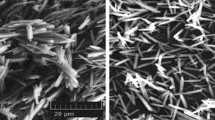Abstract
The synthesis of titanium oxycarbide by carbothermal reduction of titania was studied in hydrogen, argon, and helium in isothermal and temperature programmed reduction experiments in a tube reactor with continuously flowing gas. In the temperature range of 1000 °C to 1500 °C, the reduction rate increased with increasing temperature. Formation of titanium oxycarbide started at 1200 °C in all three gases. The reduction was the fastest in hydrogen. Formation of titanium oxycarbide in hydrogen was close to completion in 120 minutes at 1300 °C, 60 minutes at 1400 °C, and less than 30 minutes at 1500 °C. The reduction in argon and helium had similar rates and reached 90 to 95 pct after a 300-minute reduction at 1400 °C to 1500 °C. Faster carbothermal reduction of titania in hydrogen than in argon and helium was attributed to involvement of hydrogen in the reaction. Hydrogen reduced titania to titanium suboxides and reacted with carbon, forming methane, which reduced titanium suboxides to titanium oxycarbide. Titanium oxycarbide synthesized in hydrogen for 180 minutes at 1300 °C contained 13 mol pct TiO. At 1500 °C, oxygen concentration decreased to a degree corresponding to 1.4 mol pct TiO. In the titanium oxycarbide produced by a 300-minute reduction at 1600 °C, the TiO content was 0.6 mol pct.















Similar content being viewed by others
Notes
LECO is a trademark of LECO Corporation, St. Joseph, MI.
References
R. Koc, J.S. Folmer: J. Mater. Sci., 1997, vol. 32, pp. 3101–11
Handbook of Extractive Metallurgy, F. Habashi, ed., Wiley-VCH, New York, NY, vol. 2, p. 1173.
K. Das, T.K. Bandyopadhyay, S.K. Das: J. Mater. Sci., 2002, vol. 37, pp. 3881–92
A. Adipuri, G. Zhang, O. Ostrovski: Metall. Mater. Trans. B, 2008, vol. 39B, pp. 23–34
P. Lefort, A. Maitre, P. Tristant: J. Alloy. Compd., 2000, vol. 302, pp. 287–98
C.C. Chou, C.I. Lin: Br. Ceram. Trans., 2001, vol. 100, pp. 197–202
A.G. Vodop’yanov, C.V. Baranov, G.N. Kozhevnikov: Inorg. Mater., 1981, vol. 17, pp. 991–95
G. Zhang, O. Ostrovski: Metall. Mater. Trans. B, 2000, vol. 31B, pp. 129–39
G. Zhang, O. Ostrovski: Can. Metall. Q., 2001, vol. 40, pp. 317–26
M. Yastreboff, O. Ostrovski, S. Ganguly: ISIJ Int., 2003, vol. 43, pp. 161–65.
R. Kononov, O. Ostrovski, and S. Ganguly: Carbothermal Solid State Reduction of Manganese Ores, XI Int. Conf. Innovations in the Ferro Alloy Industry, New Delhi, Feb. 18–21, 2007, Macmillan India Ltd., Haryana, India, 2007, vol. 1, pp. 258–67
M.W. Chase Jr.: NIST-JANAF Thermochemical Tables, 4th ed., American Chemical Society, Washington, DC, 1998.
Acknowledgments
This research was supported under the Australian Research Council’s Linkage Projects funding scheme (Project No. LP0455085). Professor Ostrovski is the recipient of an Australian Research Council Professorial Fellowship (Project No. DP0771059).
Author information
Authors and Affiliations
Corresponding author
Additional information
Manuscript submitted May 21, 2008.
Rights and permissions
About this article
Cite this article
Dewan, M.A., Zhang, G. & Ostrovski, O. Carbothermal Reduction of Titania in Different Gas Atmospheres. Metall Mater Trans B 40, 62–69 (2009). https://doi.org/10.1007/s11663-008-9205-z
Published:
Issue Date:
DOI: https://doi.org/10.1007/s11663-008-9205-z




